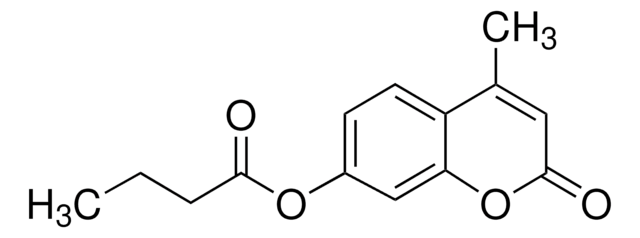U0383
Umbelliferyl Arachidonate
ethanol solution
Synonym(s):
5Z,8Z,11Z,14Z-Eicosatetraenoic acid 2-oxo-2H-1-benzopyran-7-yl ester, 7-Hydroxycoumarinyl Arachidonate
About This Item
Recommended Products
biological source
synthetic (organic)
Quality Level
assay
≥98% (HPLC)
form
ethanol solution
technique(s)
immunofluorescence: suitable
solubility
DMSO: soluble 25 mg/mL
DMF: soluble 50 mg/mL
aqueous buffer: slightly soluble
shipped in
wet ice
storage temp.
−20°C
SMILES string
CCCCC\C=C/C\C=C/C\C=C/C\C=C/CCCC(=O)Oc1ccc2C=CC(=O)Oc2c1
InChI
1S/C29H36O4/c1-2-3-4-5-6-7-8-9-10-11-12-13-14-15-16-17-18-19-28(30)32-26-22-20-25-21-23-29(31)33-27(25)24-26/h6-7,9-10,12-13,15-16,20-24H,2-5,8,11,14,17-19H2,1H3/b7-6-,10-9-,13-12-,16-15-
InChI key
SFTGFGOBCQCZDY-DOFZRALJSA-N
Application
Biochem/physiol Actions
Preparation Note
signalword
Danger
hcodes
Hazard Classifications
Eye Irrit. 2 - Flam. Liq. 2
Storage Class
3 - Flammable liquids
wgk_germany
WGK 2
flash_point_f
57.2 °F - closed cup
flash_point_c
14 °C - closed cup
ppe
Eyeshields, Faceshields, Gloves, type ABEK (EN14387) respirator filter
Certificates of Analysis (COA)
Search for Certificates of Analysis (COA) by entering the products Lot/Batch Number. Lot and Batch Numbers can be found on a product’s label following the words ‘Lot’ or ‘Batch’.
Already Own This Product?
Find documentation for the products that you have recently purchased in the Document Library.
Our team of scientists has experience in all areas of research including Life Science, Material Science, Chemical Synthesis, Chromatography, Analytical and many others.
Contact Technical Service









